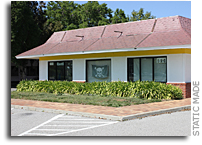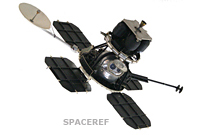50 year old NASA pictures in a whole new light, NewsFix
“In the 60’s, lunar orbiters took thousands of pictures from space, but few ever saw the originals. “They took their pictures on film and they developed them in their own little darkroom and they scanned them like an old wire photo and the signal came back to earth and they showed it on a tv screen, they then took a picture of the tv screen and printed out those pictures and took pictures of the pictures.” Explained Keith Cowing of the Lunar Orbiter Image Recovery Project Needless to say, the quality of the pictures got worse and worse.”
LOIRP Featured on CNN
"No human eye had ever seen this." Here's your peek at @NASA's lost lunar photos: http://t.co/4GZVbdzuSZ pic.twitter.com/Uiv4TBqry1
— CNN (@CNN) July 30, 2014
Lunar Orbiter Image Recovery Project Documentary by Carnegie Museum of Art is Now Online
In Part 3 of The Invisible Photograph, see how the “techno archaeologists” of the Lunar Orbiter Image Recovery Project digitally recovered the first photographs of the moon taken by a set of unmanned space probes in the 1960s. More information and Gigapan imagery.
Would-Be Rescuers of Wayward Spacecraft Previously Solved a NASA Mystery, New York Times
“Before reviving a zombie spacecraft, Dennis Wingo and Keith Cowing traveled to the past to rescue a trove of early moon photographs that otherwise would have been destined for oblivion. They did not actually time travel, but that might have been easier. Mr. Wingo, an entrepreneur and an engineer, and Mr. Cowing, the editor in chief of the NASA Watch website, had confidence that they could decipher decades-obsolete NASA equipment, because, as Mr. Cowing said, “we’ve done this before.” … The earlier project involved 1,500 magnetic tapes and a couple of old, broken tape drives. In 1966 and 1967, NASA sent five robotic spacecraft, the Lunar Orbiters, to photograph the moon’s surface to help find safe landing sites for the Apollo astronauts. The tapes, which recorded the original high-resolution images, and the tape drives ended up in the garage of a former NASA employee, and Mr. Wingo and Mr. Cowing embarked on a quixotic mission to retrieve the images.”
LOIRP Film Premieres at Carnegie Museum of Art
|
|
Extraterrestrial: The Lunar Orbiter Image Recovery Project
 2-Minute Film Festival goes to the moon, Pittsburgh Post Gazette
2-Minute Film Festival goes to the moon, Pittsburgh Post Gazette
The lunar orbiter project is made up of “a group of dedicated space industry professionals who have worked for several years to digitally recover the first photographs of the moon and the first photographs of Earth taken from the moon,” Ms. Heffley said. Their work site is an abandoned McDonald’s on a NASA naval air station in Mountain View, Calif. When the Carnegie Museum film crew arrived in March, the team of techno-archaeologists had just digitized the final of the more than 1,400 magnetic tapes.
Extraterrestrial: The Lunar Orbiter Image Recovery Project and The 2-Minute Film Festival
Join us for the world premiere of Extraterrestrial, Part 3 of The Invisible Photograph. Begin the evening with a look into the Lunar Orbiter Image Recovery Project. See how a team of techno-archaeologists digitally recovered the first photographs of the moon, taken by unmanned space probes and used to determine the landing sites for the Apollo missions of the 1960s and the 1970s. Then join us in the Sculpture Court for a screening of finalists from this year’s 2-Minute Film Festival, showcasing films that explore the concept of outer space–in two minutes or less. Picnic food and bar open in the Sculpture Court beginning at 7:30 p.m.
The Invisible Photograph, a production of the Hillman Photography Initiative, is a five-part documentary series investigating the expansive realm of photographic production, distribution, and consumption by way of the hidden side of photography.
8:15-9 p.m.- Screening of Extraterrestrial with Keith Cowing, co-lead of the Lunar Orbiter Image Recovery Project and Divya Rao Heffley, Program Manager of the Hillman Photography Initiative.
9:15-11 p.m.- 2-Minute Film Festival, back for the 4th time!
$10; includes one drink ticket!
Culture Club is sponsored by: Great Lakes Brewing Company, Macy’s, and Bill Few Associates
Scott Manley Visits The Lunar Orbiter Image Recovery Project
McMoons, LOIRP, and ISEE-3 Make Front Page of the New York Times
 Calling Back a Zombie Ship From the Graveyard of Space, New York Times (front page story)
Calling Back a Zombie Ship From the Graveyard of Space, New York Times (front page story)
“For 17 years, [ISEE-3] has been drifting on a lonely course through space. Launched during the disco era and shuttered by NASA in 1997, the spacecraft is now returning to the civilization that abandoned it. It seemed destined to pass without fanfare, except for a slight chance of slamming into the moon, and then loop aimlessly through the inner solar system. But now, a shoestring group of civilians headquartered in a decommissioned McDonald’s have reached out and made contact with it — a long-distance handshake that was the first step toward snaring it back into Earth’s orbit. … Mr. Wingo and Keith Cowing, the editor of NASA Watch, a sometimes cantankerous website covering news and gossip about the space agency, had previously collaborated on a project that resurrected equipment to read 50-year-old magnetic tapes, extracting high-resolution images taken by NASA lunar orbiters in the 1960s — a task NASA had also regarded as infeasible. Mr. Wingo and Mr. Cowing decided ISEE-3 was another worthy effort.”
Carnegie Museum of Art LOIRP Documentary Premiere
.jpg)
2-Minute Film Festival, Carnegie Museum of Art
Join us under the stars as we reveal this year’s finalists-and give you the chance to vote for your favorite! Each year we pick a unique theme and ask filmmakers to submit their finest–and shortest–films to our 2-Minute Film Festival. To celebrate the interstellar premiere of Extraterrestrial: The Lunar Orbiter Image Recovery Project, part of the Hillman Photography Initiative’s Invisible Photograph documentary series, this year’s filmmakers explored the concept of outer space. With so much room for interpretation, we received a wide array of stellar entries from across the country and around the globe, and we can’t wait to share them with you!
Note: LOIRP Co-lead Keith Cowing will be a guest of the Carnegie Museum of Art as this film featuring the Lunar Orbiter Image Recovery Project is shown in public on 10 July 2014 for the first time.
Visiting McMoons and the Lunar Orbiter Image Recovery Project
 A Week With Techno-Archeologists, Static Made
A Week With Techno-Archeologists, Static Made
“I’ve spent the past week in Mountain View, California, hanging out with a group of Lunar Orbiter Image Recovery Project (LOIRP) hackers who are working out of an abandoned McDonald’s on the NASA Ames base. For more than five years, LOIRP technologists (or techno-archeologists, as they prefer to be called) have been reverse-engineering analog tape drives and developing new software in an attempt to unearth some of the first images of the moon that were taken by unmanned lunar orbiters in advance of the manned Apollo missions of the late 1960s. Upon entering the building (affectionately called “McMoon’s” by those who work within it) for the first time, I was greeted by familiar architecture. The drive-thru windows, menu light boxes, stainless steel counters, fiber glass tables and the ghosts of corporate brand ephemera all remain. However now they coexist under a jolly roger with a literal mountain of vintage 2-inch tape reels that contain trapped data, refrigerator-sized Ampex tape drives, an army of Mac workstations and a seemingly endless supply of analog tape decks, monitors, cables and soldering supplies.”
Images from the Carnegie Museum of Art team’s visit to McMoons last week on Flickr
LOIRP In The News
 Engineers Are Rescuing Some of the First Photos Ever Taken from Lunar Orbit , Smithsonian
Engineers Are Rescuing Some of the First Photos Ever Taken from Lunar Orbit , Smithsonian
“The tapes that recorded the data beamed back to Earth, though, captured the photos in all their glory. Unfortunately, NASA held on to the tapes but tossed out the equipment used to read them. The efforts of the team behind the Lunar Orbiter Image Recovery Project, says Bierand, has so far given 2,000 old photos new life, including the Earthrise photo above, captured in 1966 and re-released a few years ago.”
LOIRP In The News
 McMoon’s revealed: Inside the hacker project that’s saving NASA’s lunar photos, Imaging Resource
McMoon’s revealed: Inside the hacker project that’s saving NASA’s lunar photos, Imaging Resource
“We’ve all been there: Media comes and goes, and despite your best efforts to keep your photo archives current, eventually you find a stray. Perhaps it’s an old Iomega Zip disk that got misplaced, or a floppy from your Sony Mavica that you found at the bottom of a drawer. Either way, you know there are photos on there, but you lack the hardware necessary to get at them. Your Zip drive long ago succumbed to the click of death, and seriously… when’s the last time you saw a computer with a floppy drive? It might surprise you, though, to learn that the same thing happened to photos shot by NASA while it was seeking out the best potential landing sites for the Apollo program.”
Lost 1960s moon photos recovered from analog tapes
“As the Beatles warmed up to play Shea Stadium for the second time, in August of 1966 a NASA satellite was quietly snapping images of the moon onto 70mm film and processing them in its robotic body before beaming the resulting images back to the Earth over analog radio waves.”
LOIRP Featured in ExtremeTech
 How hackers restored NASA’s lost lunar photos from inside an old McDonald’s, ExtremeTech
How hackers restored NASA’s lost lunar photos from inside an old McDonald’s, ExtremeTech
“The Lunar Recovery Project team has released new footage of restored lunar photos from NASA’s early probes and the difference in image quality between the old publicly released photos and the new material is simply stunning. The story of how the material was rescued is equally inspiring — the quest to preserve this material dates back to 1986, when JPL archivist Nancy Evans decided she could not, in good conscience, simply throw the old material away.”
